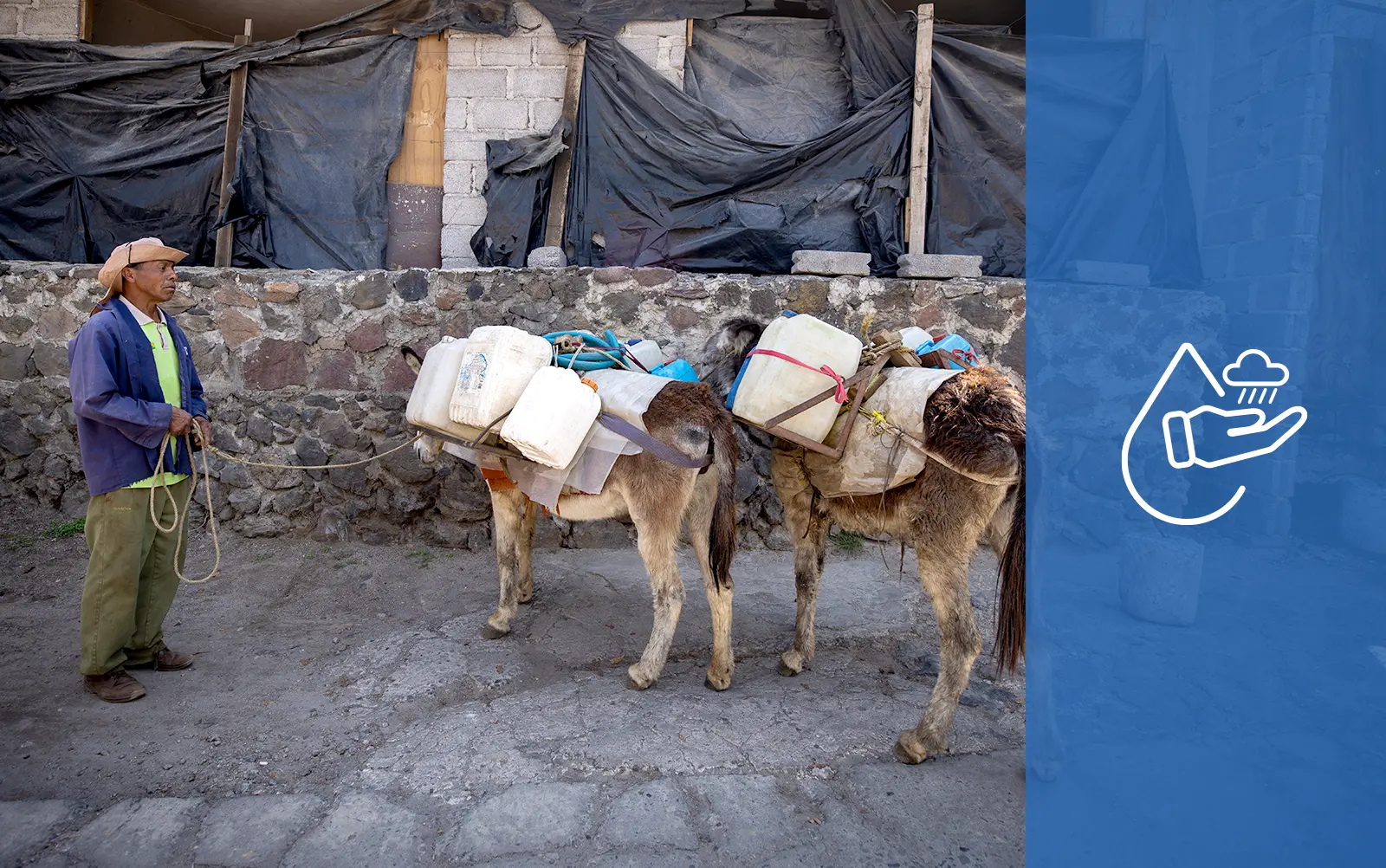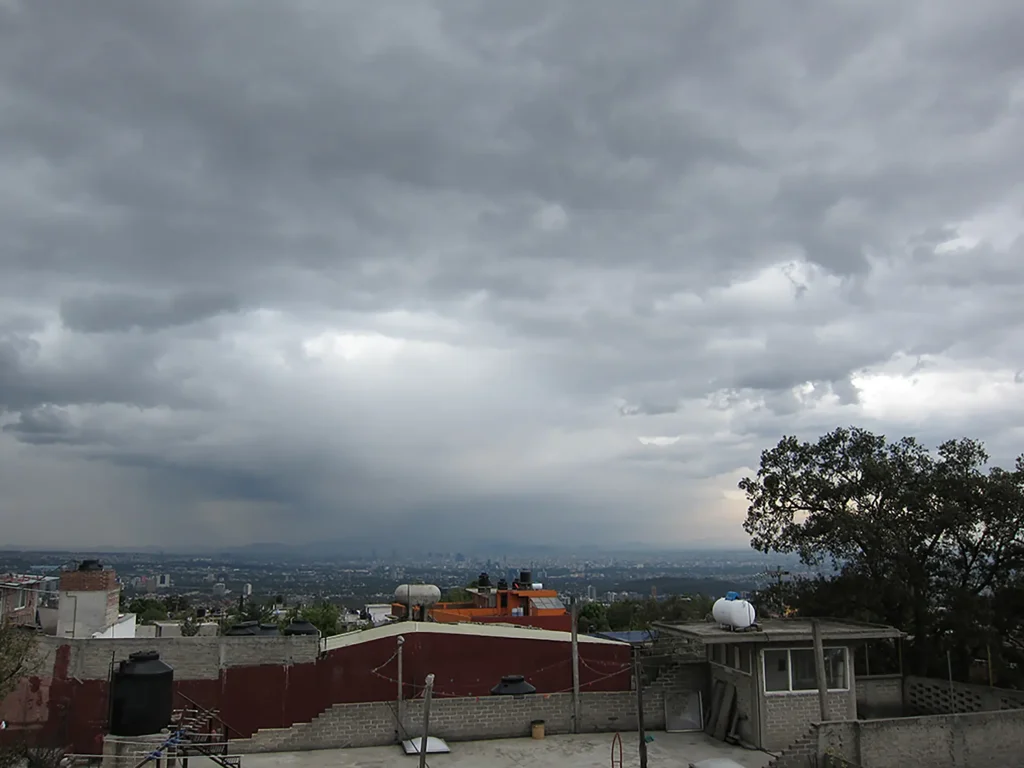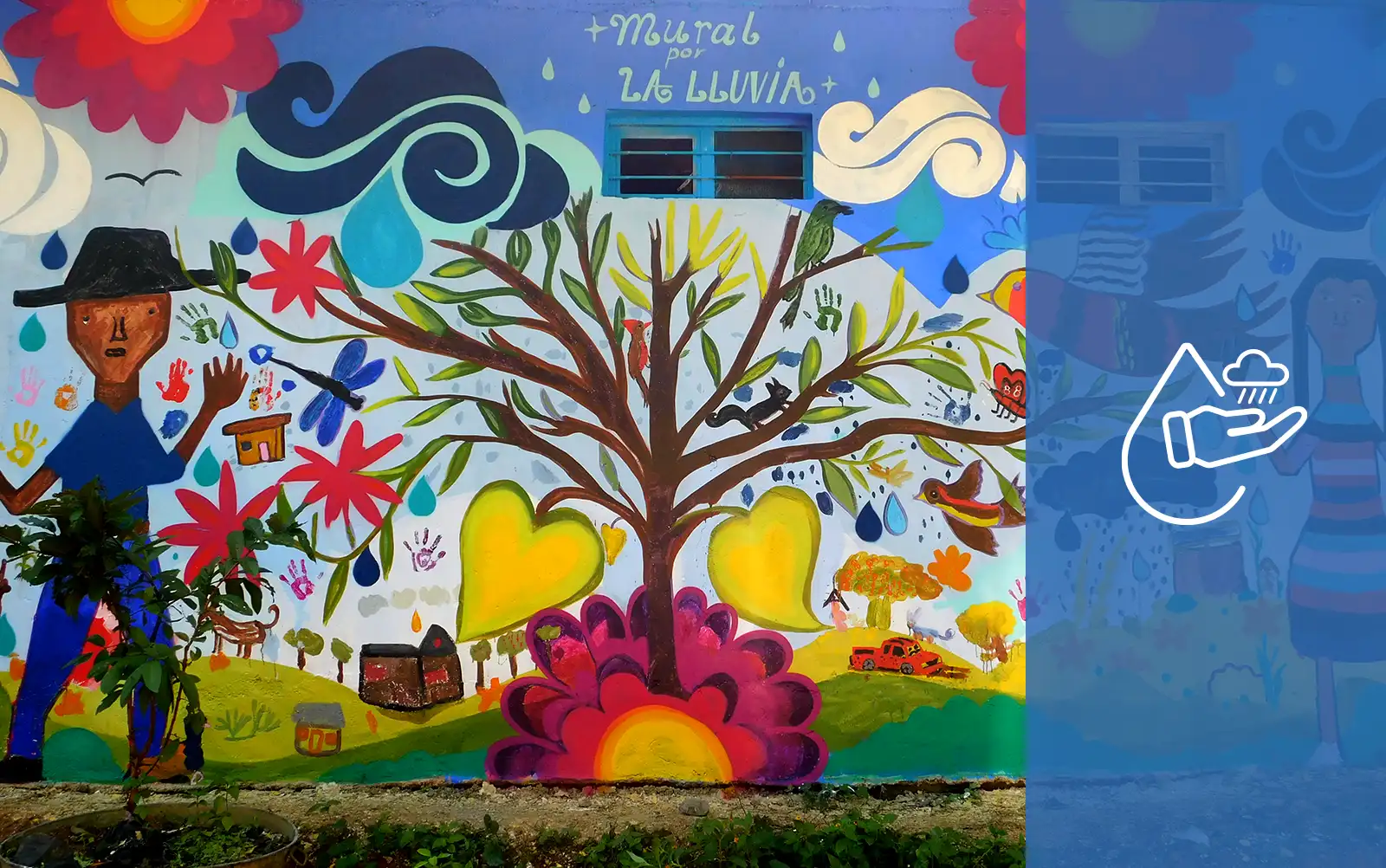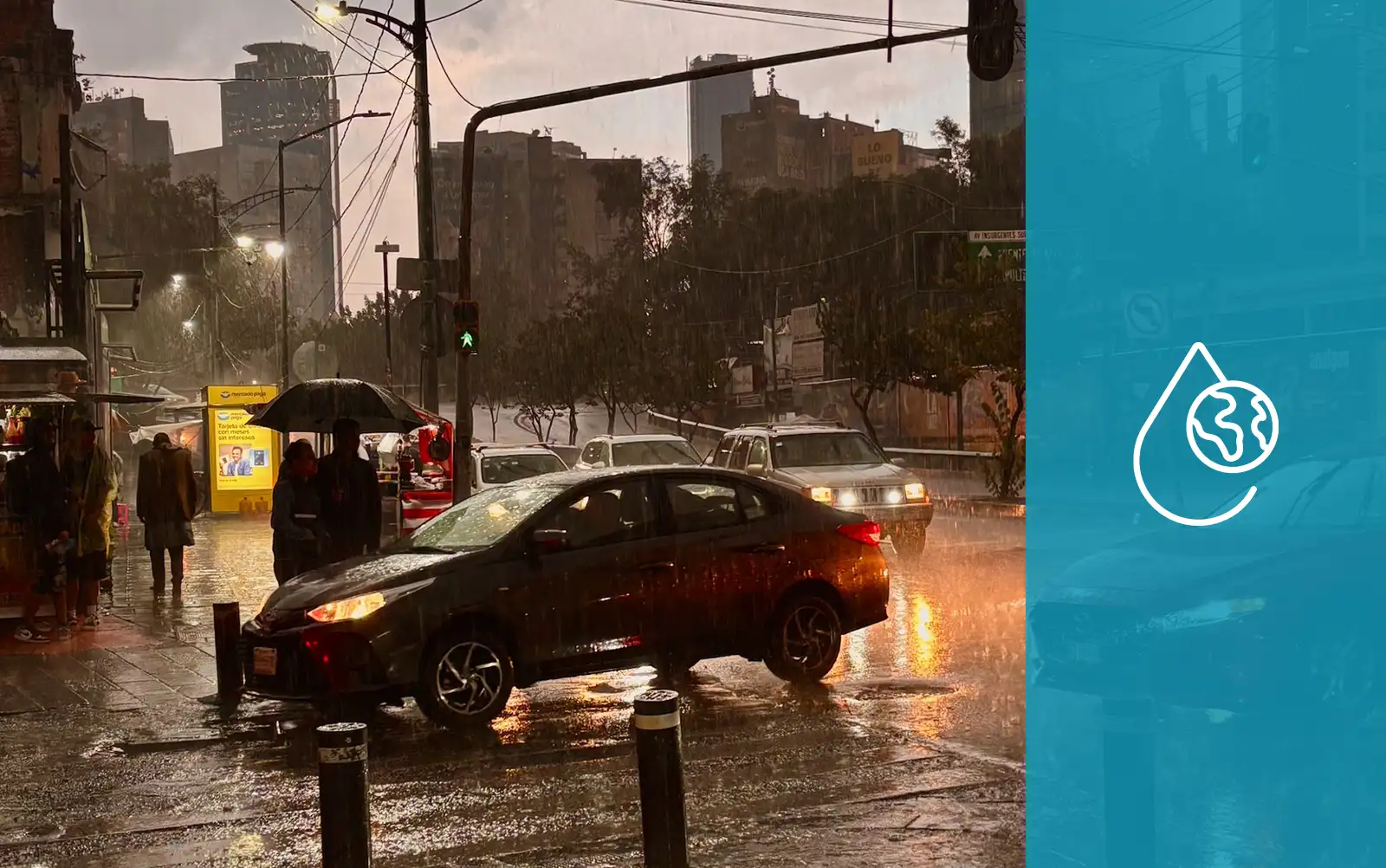
Lluvia Para Todos: How Rainwater Harvesting Transforms Communities in Mexico
By: Sean Donnelly
In the heart of Mexico City—one of the largest and most densely populated urban areas in the world—millions wake each morning uncertain if water will flow from their taps. Despite seasonal deluges and torrential summer rains, the city and much of the country are facing an escalating water crisis. Decades of over-extraction, inadequate infrastructure, and a growing climate emergency have left reservoirs depleted and aquifers shrinking. In some neighborhoods, especially in the city’s sprawling outskirts, residents go days or even weeks without running water, relying instead on costly and unreliable truck deliveries. In Mexico at large, 12 million people lack access to potable water and only 14% of households receive water 24 hours a day. In rural areas, 8 out of 10 people live without access to basic water services. Nationwide, water scarcity impacts millions of people every day. According to the United Nations, access to clean water is a human right.

In many parts of the world, when water is scarce, it is women and young girls who carry the heaviest load—literally. In households lacking piped water, women and girls are responsible for collecting it in roughly 7 out of 10 cases, with girls almost twice as likely as boys to take on this role. Per UNICEF, this daily task consumes up to 200 million hours, collectively, around the world—time that could otherwise be spent in school, earning income, or participating more fully in community life. Collecting water becomes time-consuming work that takes away from school, jobs, and other opportunities, reinforcing long-standing gender inequalities.
But amid the scarcity, a quiet revolution is taking shape—on rooftops, in schools, and across rural and urban communities alike. Rainwater harvesting, a simple yet powerful solution, is transforming communities. According to UNICEF, 1 out of every 100 liters of rainwater is harvested for use globally – and according to Isla Urbana, therein lies the solution for the water issue in Mexico. The Mexico City based nonprofit organization has spent over a decade demonstrating how simple rainwater harvesting systems can make a big difference. Since 2009, the group has installed more than 40,000 systems across Mexico—mostly in areas where water service is unreliable or nonexistent. The systems collect, filter, and store rainwater from rooftops, giving families a steady, local source of clean water without depending on expensive and inconsistent truck deliveries. A well-designed rainwater harvesting system has the capacity to meet a household’s water needs—including drinking water—for anywhere from five to twelve months each year, depending on rainfall and system size. By capturing and storing rain during the wet season, these systems help reduce reliance on overexploited aquifers, allowing them time to naturally recharge. In addition to easing environmental stress, rainwater harvesting also lowers the financial and ecological costs associated with water transportation, offering both economic and sustainability benefits to communities. Isla Urbana estimates that their rainwater harvesting systems harvest 6.6 billion liters of rainwater annually.


Isla Urbana’s approach is unique in its recognition of the human dimension of the water crisis. By providing families with direct access to water, these systems alleviate daily burdens and create new opportunities—particularly for women and children. With less time spent on water collection and fewer physical demands, individuals can focus on education, employment, and other pursuits that strengthen the entire community. From families who now cook and bathe with confidence to schools where children no longer miss class due to water shortages, communities are reclaiming agency over a resource long taken for granted. What began as a grassroots response to government inaction is now a model of resilience and environmental justice. It’s a simple idea with far-reaching impact—and one that could work in other parts of the world facing similar challenges, if given the right support.
Isla Urbana’s rainwater harvesting systems are designed to be both effective and easy to maintain. Rainwater is collected from a clean, well-maintained roof and funneled into a system of gutters. From there, it passes through a first-flush diverter—known as a Tlaloque—which discards the initial flow of rain, removing roughly 75% of surface contaminants. Water then passes through a secondary filter, which captures larger debris like leaves and branches.
The filtered water then enters a storage tank through a calmed inlet, which helps slow the flow of water to allow for additional sedimentation to settle at the tank’s bottom. A pump with a floating intake draws water from just below the surface, where it is cleanest. Depending on the system’s configuration and the level of water quality required, additional filtration can be added to remove finer particles.
With proper design and regular maintenance, these systems can provide high-quality water for nearly all household uses. When equipped with a final purification stage—such as a gravity-fed filter—the water becomes safe for drinking and cooking as well.

Isla Urbana prioritizes initiatives that promote social and environmental justice. Their webpage outlines their community-centered programs and highlights how their work impacts specifically women, schools, and indigenous communities. In the following passages, I will seek to explore and share some of the real-world impacts this organization is having with respect to those groups, and to tell some of their stories.
In November, I had the opportunity to travel with a cohort of graduate students and faculty from Virginia Tech’s Executive Master of Natural Resources (XMNR) program to Paraje Quiltepec, an informal settlement in Mexico City. We were joined by Delfín Montañana, Director of Socio-Environmental Education at Isla Urbana, who guided us through the community and shared how the organization is working directly with families to address water insecurity. Seeing Isla Urbana’s impact firsthand inspired me to maintain a relationship with the organization and to do what I can to help them in accomplishing their mission.
According to the University of Pennsylvania, 22 percent of Mexico City and between 60 and 70 percent of the Mexican countryside consists of informal settlements (Gutierrez). These communities were not designed with zoning and building codes that ensure access to any municipal water supply. Accordingly, families in informal settlements are often left to find their own solutions to collect water and the responsibility falls overwhelmingly on women and girls. Prior to Isla Urbana’s involvement in the community, Paraje Quiltepec was one of those communities.

Elena Cruz. Photo by Sarah Tesla.
“Before there were public roads, the water truck could not arrive” explained Elena Cruz outside of her home in Paraje Quiltepec. Accessing water was a daily challenge for Elena long before Isla Urbana’s rainwater harvesting system was installed. For years, her only source came through a hose extended from the home of a generous neighbor, running through several adjoining properties.
If the hose became blocked—by debris or a kink in the line—she had to trace it back on foot. When the obstruction was located on someone else’s property and they weren’t home, there was little she could do but wait. “They would use hoses from the nearest road to deliver the water to us. If the neighbors were not home that day or the hose was obstructed for any reason, we would simply go without water.” Elena explained that water trucks, which only became an option after the community came together to build their own roads, were an expensive and inconsistent option that added their own complications. Her family had to request water at the municipal level or through private water providers each time their storage tanks need refilling. Private deliveries by truck can be costly, costing an average of $75 per household per month. Comparatively, a rainwater harvesting system like hers costs an average of $3 per month. Additionally, each truck delivery requires scheduling in advance. Residents are told their water delivery will arrive at their residence sometime between one and fifteen days. This requires someone to remain at home at all times during that window or risk missing the precious opportunity to resupply. Women are frequently the ones who are tasked with waiting for the trucks to arrive.

In communities like Elena’s, Isla Urbana works with residents to install rooftop rainwater harvesting systems that expand access to clean water while easing financial burdens. With a reliable water source, families are able to reallocate time and resources toward critical needs such as education and healthcare. Elena credits the stability provided by the system with helping her children pursue university degrees and build successful professional lives. Consistent water access also contributes to improved hygiene, reduces strain on sewage infrastructure, and lowers the risk of waterborne illnesses—strengthening both individual and public health outcomes.
Isla Urbana’s systems have, quite literally, changed Elena’s life. Water security has opened doors to new opportunities for herself and her children. Harvesting rainwater has allowed her to increase the yield of the fruit trees in her yard consistently, trees whose yields have helped feed her family, as well as offering an additional stream of income. Her children were able to stay in school and pursue lucrative and rewarding careers. Improved water security has totally changed what might be possible for her family’s future. Elena explained, “Not only do we have clean drinking water, but I also use the grey water to grow fruit trees. The fruits we gather produce jams that we sell, among other produce, which has financed my children’s education. They studied computer engineering.” The impact of Isla Urbana’s work extends beyond reducing the time women and girls spend collecting water. Many women in the community are trained as system installers and advocates, challenging traditional gender roles and becoming agents of change. Elena Cruz is one such example. She was the first in her community to invest in a rainwater harvesting system. Her example encouraged her neighbors to put faith in Isla Urbana, when trust in municipal systems was all but lost due to long delays in delivery and a persistent failure by authorities to follow through.





The story of Paraje Quiltepec and Isla Urbana highlights the powerful connection between water security and gender equity—reminding us that, in some cases, solutions really can fall from the sky. The organization’s work demonstrates that meaningful community engagement is essential; when residents are directly involved in the design and implementation of solutions, those efforts are more effective, more sustainable, and more widely embraced.
By improving access to water, Isla Urbana is not only helping women and girls reclaim their time and pursue opportunities—they’re also fostering leadership. When women are empowered to lead on issues of water access, the benefits extend far beyond the individual, creating ripple effects that strengthen entire communities.

In Mexico City, water represents more than survival. For many women, it means freedom, opportunity, and agency. Isla Urbana’s work is a testament to what becomes possible when water is seen not just as a basic need, but as a pathway to justice. Through innovation, community partnerships, and a commitment to gender equity, the organization is setting an example with global relevance—one rooftop at a time. For Elena Cruz and thousands like her, rainwater harvesting is more than a technical solution—it’s a symbol of dignity, resilience, and possibility. In a city where water too often equals struggle, Isla Urbana is proving that equity can fall from the sky—if we’re willing to catch it.

